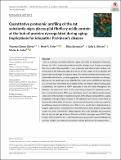Files in this item
Quantitative proteomic profiling of the rat substantia nigra places glial fibrillary acidic protein at the hub of proteins dysregulated during aging : implications for idiopathic Parkinson’s disease
Item metadata
| dc.contributor.author | Gómez-Gálvez, Yolanda | |
| dc.contributor.author | Fuller, Heidi R. | |
| dc.contributor.author | Synowsky, Silvia | |
| dc.contributor.author | Shirran, Sally L. | |
| dc.contributor.author | Gates, Monte A. | |
| dc.date.accessioned | 2020-04-09T15:30:03Z | |
| dc.date.available | 2020-04-09T15:30:03Z | |
| dc.date.issued | 2020-04-09 | |
| dc.identifier | 267341550 | |
| dc.identifier | 940af3b1-9a24-4183-89ac-83e51e61c52a | |
| dc.identifier | 85083059526 | |
| dc.identifier | 000534214000011 | |
| dc.identifier.citation | Gómez-Gálvez , Y , Fuller , H R , Synowsky , S , Shirran , S L & Gates , M A 2020 , ' Quantitative proteomic profiling of the rat substantia nigra places glial fibrillary acidic protein at the hub of proteins dysregulated during aging : implications for idiopathic Parkinson’s disease ' , Journal of Neuroscience Research , vol. Early view . https://doi.org/10.1002/jnr.24622 | en |
| dc.identifier.issn | 0360-4012 | |
| dc.identifier.other | RIS: urn:5394E8819F27164FDE48FDBAAB5550ED | |
| dc.identifier.other | ORCID: /0000-0003-3516-3507/work/71954860 | |
| dc.identifier.uri | https://hdl.handle.net/10023/19776 | |
| dc.description | This work was made possible by generous funding from the Keele University ACORN scheme and Keele University School of Medicine. | en |
| dc.description.abstract | There is a strong correlation between aging and onset of idiopathic Parkinson's disease, but little is known about whether cellular changes occur during normal aging that may explain this association. Here, proteomic and bioinformatic analysis was conducted on the substantia nigra (SN) of rats at four stages of life to identify and quantify protein changes throughout aging. This analysis revealed that proteins associated with cell adhesion, protein aggregation and oxidation‐reduction are dysregulated as early as middle age in rats. Glial fibrillary acidic protein (GFAP) was identified as a network hub connecting the greatest number of proteins altered during aging. Furthermore, the isoform of GFAP expressed in the SN varied throughout life. However, the expression levels of the rate‐limiting enzyme for dopamine production, tyrosine hydroxylase (TH), were maintained even in the oldest animals, despite a reduction in the number of dopamine neurons in the SN pars compact(SNc) as aging progressed. This age‐related increase in TH expression per neuron would likely to increase the vulnerability of neurons, since increased dopamine production would be an additional source of oxidative stress. This, in turn, would place a high demand on support systems from local astrocytes, which themselves show protein changes that could affect their functionality. Taken together, this study highlights key processes that are altered with age in the rat SN, each of which converges upon GFAP. These findings offer insight into the relationship between aging and increased challenges to neuronal viability, and indicate an important role for glial cells in the aging process. | |
| dc.format.extent | 16 | |
| dc.format.extent | 1911288 | |
| dc.language.iso | eng | |
| dc.relation.ispartof | Journal of Neuroscience Research | en |
| dc.subject | Aging | en |
| dc.subject | Dopaminergic neuron | en |
| dc.subject | Glial fibrillary acidic protein | en |
| dc.subject | Proteome | en |
| dc.subject | Proteomics | en |
| dc.subject | RRID:AB_11145309 | en |
| dc.subject | RRID:AB_2109791 | en |
| dc.subject | RRID:AB_228307 | en |
| dc.subject | RRID:AB_228341 | en |
| dc.subject | RRID:AB_2336820 | en |
| dc.subject | RRID:AB_2631098 | en |
| dc.subject | RRID:AB_390204 | en |
| dc.subject | RRID:MGI:5651135 | en |
| dc.subject | RRID:SCR_001881 | en |
| dc.subject | RRID:SCR_002798 | en |
| dc.subject | RRID:SCR_003070 | en |
| dc.subject | RRID:SCR_004946 | en |
| dc.subject | RRID:SCR_005223 | en |
| dc.subject | Substantia nigra | en |
| dc.subject | RC0321 Neuroscience. Biological psychiatry. Neuropsychiatry | en |
| dc.subject | DAS | en |
| dc.subject.lcc | RC0321 | en |
| dc.title | Quantitative proteomic profiling of the rat substantia nigra places glial fibrillary acidic protein at the hub of proteins dysregulated during aging : implications for idiopathic Parkinson’s disease | en |
| dc.type | Journal article | en |
| dc.contributor.institution | University of St Andrews. School of Chemistry | en |
| dc.contributor.institution | University of St Andrews. School of Biology | en |
| dc.contributor.institution | University of St Andrews. Biomedical Sciences Research Complex | en |
| dc.identifier.doi | https://doi.org/10.1002/jnr.24622 | |
| dc.description.status | Peer reviewed | en |
This item appears in the following Collection(s)
Items in the St Andrews Research Repository are protected by copyright, with all rights reserved, unless otherwise indicated.

